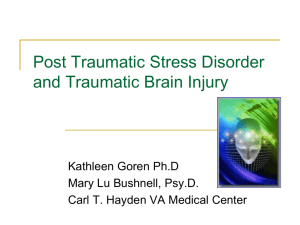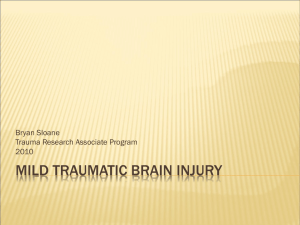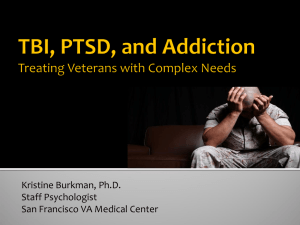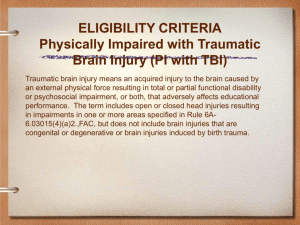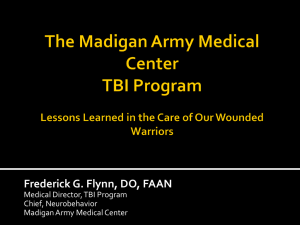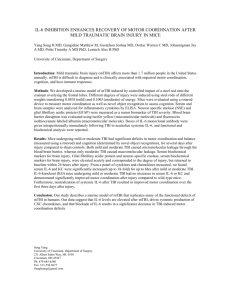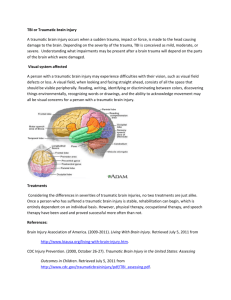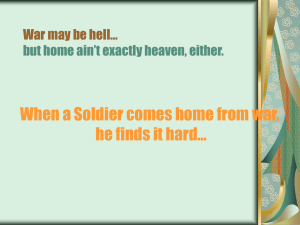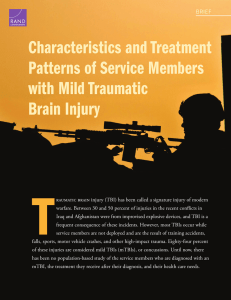PowerPoint of this Presentation
advertisement
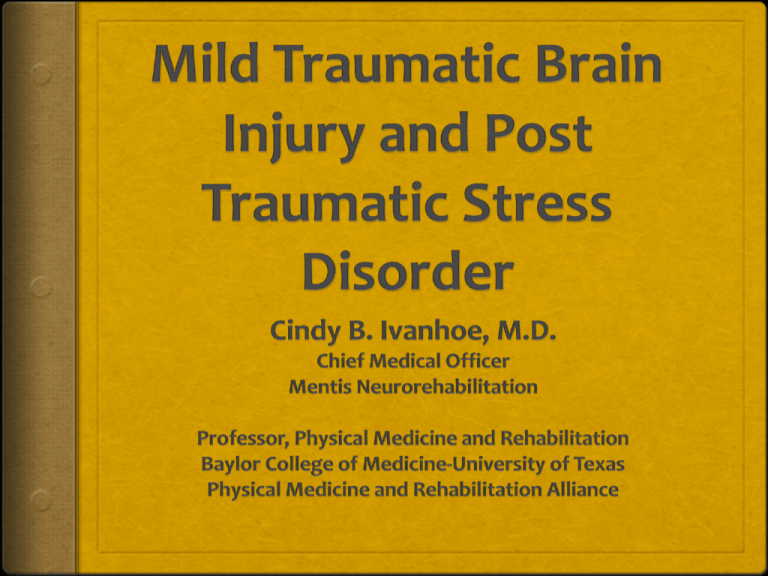
Mild Traumatic Brain Injury Classification if based on initial presentation; not outcome Variable definitions Include loss of consciousness less than 30 minutes, PTA less than 24 hours, and/or other neurologic abnormalities Uncomplicated vs. complicated MTBI GCS 13-15 Definition of MTBI Mild TBI (or concussion): a diagnosis based solely on observed or reported injury severity characteristics following a head trauma Length of loss of consciousness (LOC) < 30 min Length of posttraumatic amnesia (PTA) < 24 hrs Time to follow commands (TFC) < 1 hr There is abundant, conclusive evidence that structural, pathophysiological, and cognitive/behavioral changes occur Occur immediately following mild TBI (McCrea, 2008) Subjective complaints and mild concentration and memory problems typically resolve within 3 months post injury (Schretlen & Shapiro, 2003) Post Concussive Syndrome A constellation of largely subjective somatic, cognitive, and affective symptoms that persist following mild TBI Diagnosed > 3 months post-injury Boake et al (2005) found widely varying prevalence rates DSM-IV) extremely poor specificity Pre- and post-injury psychiatric distress, older age, chronic pain, sleep disturbance Compensation seeking associated with the development of PCS Mild TBI At least 25% of individuals with mild TBI do not seek medical care Approximately 14% seek care from physicians Majority of athletic mild TBIs are not reported Civilians-usual cause is falls or motor vehicle collisions with acceleration-deceleration Occur under less stressful situations Mild TBI: Mechanism Axonal injury-stretch starts a pathophysiologic process that leads to metabolic dysfunction Neurons that survive are often structurally compromised Neuron survival is linked to mitochondria and other metabolic tendencies and biomarkers Second Impact Syndrome (SIS) Mostly related to sports activities Still having symptoms from an impact, when the next impact occurs Leads to sustained intracranial hypertension, sustained cerebral edema Significance of “still having symptoms” as recovery is not linear and symptoms may not correlate with degree of damage Blast Injury: Mechanisms of Injury Blast causes rapid pressure changes, especially in organs with air-fluid interfaces Brain may be affected as well by transmission of energy via the great vessels in the thorax and/or orifices of the skull (Eyes, ears) Electromagnetic changes following the blast Debris Toxic inhalation, radiation, body displacement Mild TBI in the Military Under recognized in cases of polytrauma 82% of TBI in this population-mild or “concussive” Likely to occur under some degree of physiologic stress at time of injury Usually associated with blast injury Combination of blunt and blast injury TBI in the Military Start of Afghanistan War October 7, 2001 Start of Iraq War March 20, 2003 TBI Severity in the Military May Impact Physiology of the injury Temperature extremes Dehydration Fatigue Chronic cortisol elevations IMAGING CT MRI SINGLE PHOTON EMISSION COMPUTERIZED TOMOGRAPHY (SPECT) DIFFUSION TENSOR IMAGING (DTI) Post Traumatic Stress Disorder The person has experienced, witnessed, or been confronted with an event or events that involve actual or threatened death or serious injury, or a threat to the physical integrity of oneself or others. The person's response involved intense fear, helplessness, or horror. PTSD: DSM IV • Trauma (The “Stressor”) • Re experiencing / Intrusions • Avoidance/Numbing • Increased Arousal • More than one month of symptoms • Causes functional problems PTSD Reexperiencing (need at least 1) Recurrent and intrusive distressing recollections of event Recurrent distressing dreams of the event Acting or feeling as if the traumatic event were recurring (e.g., flashbacks) Intense psychological distress at exposure to internal or external cues Physiological reactivity to cue exposure PTSD Avoidance and Numbing (need at least 3) Efforts to avoid thoughts, feelings, or conversations associated with trauma Efforts to avoid activities, places, or people that arouse recollections of trauma Inability to recall important aspects of trauma Markedly diminished interest or participation in significant activities Feeling of detachment or estrangement from others Restricted range of affect Sense of foreshortened future PTSD Increased arousal (need at least 2) Difficulty falling or staying asleep Irritability or outbursts of anger Difficulty concentrating Hypervigilance Exaggerated startle response Acute Stress Disorder Most individuals experience PTSD symptoms immediately following a traumatic experience If symptoms last less than 4 weeks, then it is considered acute stress disorder. Given that most people experience similar symptoms after a trauma, what differentiates between those that recover vs. those that develop long term PTSD? PTSD Reexperiencing (need at least 1) Recurrent and intrusive distressing recollections of event Recurrent distressing dreams of the event Acting or feeling as if the traumatic event were recurring (e.g., flashbacks) Intense psychological distress at exposure to internal or external cues Physiological reactivity to cue exposure Mild TBI and PTSD Patients who have both MTBI and PTSD report more symptoms than those with TBI alone Brenner, Ivins, Schwab, et al. J Head trauma Rehabil 2010 TBI and PTSD: Symptom Overlap Frequent coexist in the military population PTSD is more common in those with milder TBIs Persistent symptoms multifactorial Memory deficits, balance deficits, irritability, fainting spells, fatigue, sleep disorders, ringing in the ears prevalent in both Only headache found to be more associated with MTBI MTBI and PTSD: Remote Injury Headache, memory problems, sleep disturbances, fainting, more associated with MTBI than PTSD Cognitive issues attributed to both conditions Processing speed and executive functions more impaired in those with TBI and PTSD, as opposed to TBI alone Treatment is still compensatory techniques and symptomatic Athletes and MTBI Athletes are more susceptible to future MTBI after a MTBI and recover more slowly after multiple MTBIs (Guskiewicz et al., 2003) Miller et al. (2013) and Lippa et al. (2010) found no difference in self-reported post concussive symptoms in service members and Veterans in the post acute recovery period following multiple concussions Imaging Considerations CT rarely useful MRI rarely useful Magnetic resonance diffusion tensor imaging can detect microstructural changes in white matter following (m)TBI that are associated with Cognitive performance and PCS symptoms (Lipton et al, 2009; Niogi et al, 2008; Wilde et al, 2008) Functional Assessment Work, School, Family relationships, Housing, Legal Financial, Unit/community involvement Available at http://www.healthquality.va.gov/mtbi/concussion_m tbi_full_1_0.pdf General Principles of Management Symptom based and supportive Avoid narcotics and benzodiazepines Avoid iatrogenic impairments Interdisciplinary Value their symptom reports Symptoms Seen In MTBI Headache Visual Vestibular and Hearing Sleep Disturbances Mood/Behavior Cognitive deficits Headache Episodic NSAIDS Triptans Combinations such as Fioricet, fiorinal, midrin Chronic daily Antidepressants-sleep vs. mood Antiepileptic drugs Beta blockers Botulinum toxins Vision Complaints often nonspecific Saccadic abnormalities twice as high in blast injury Problems with convergence and accommodation Treatment may include patching, prisms, vision therapy, surgery Vestibular Dysfunction Damage can occur to the peripheral and/or central nervous systemic The only sensory system where unilateral injury can cause so much threat to well being Complaints of unsteadiness, falling, lightheadedness Consider benign paroxysmal positional vertigo, post traumatic migraine (aura), perilymphatic fistula Vestibular Function and Hearing Temporal bone fractures, especially transverse Blunt and penetrating and blast injury Conductive and/or sensorineural hearing loss Transverse fractures Treatment Hearing aides Surgery Vestibular therapy Medications Maximize vision Sleep Disorders Insomnia-dissatisfaction with the quality or quantity of sleep Sleep related breathing disorders Narcolepsy Post traumatic hypersomnia Circadian rhythm sleep disorders Treatment: Lifestyle, medications, CPAP Sleep Studies Pharmacologic Management Treating the symptoms Avoid cognitively impairing medications Role of melatonin Limiting medications; on stone, 2 birds Treat sleep, anxiety, mood, pain, cognition, hormones Return to Life School Work Risk factors are diverse Usually, good recovery Pre-injury, peri-injury, and post-injury factors have all been found to contribute to the abnormal persistence of postconcussive symptoms (a condition called Post Concussional Disorder or Postconcussive Syndrome) Pre-injury risk factors Peri-injury risk factors Post-injury risk factors Psychiatric conditions Depression Social Difficulties Female gender Anxiety Environmental stress Older age Stress Chronic pain Sleep disturbance Secondary gain McCrea et al., 2008 Suicide Risk is greater in males than females by 4-5:1 “Evidence Based Medicine” What precipitates it? What factors influence it? Finances, interest…. Who is it done on? How is it used? Negative Length of follow up Negative studies “Controlled” Medical creativity Implications for Future Considerations Blast injuries are leading to changes in safety technology Increase in screening procedures for returning soldiers Need to clarify role of gender and age differences as modifying factors Currently, limiting exposure is the only way to prevent injury Closing Thoughts Psychological comorbidities can complicate management or not Symptomatology is real The brain it happened to, is the brain it happened to Understanding and treatment is an art; a work in progress Consider the culture of injured person Closing Thoughts Basic principles of Brain Injury Medicine apply Treatment is primarily symptom based Limit sedating, cognitively impairing medications Listening: a lost art Create a supportive environment Avoid creating a professional patient/lifer
